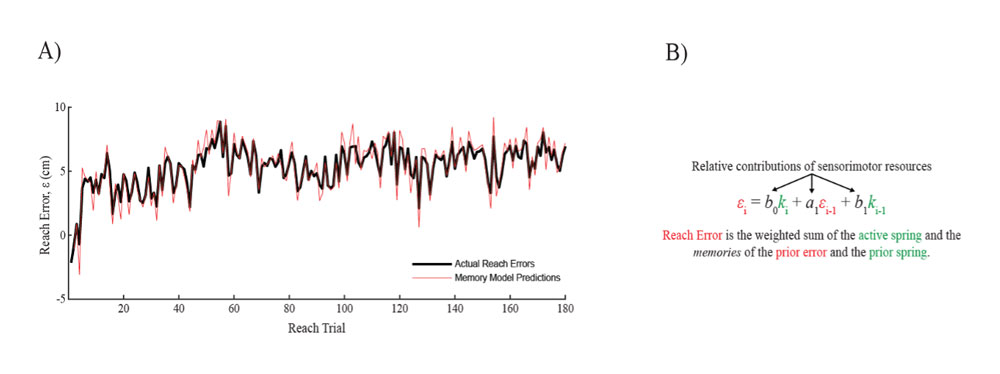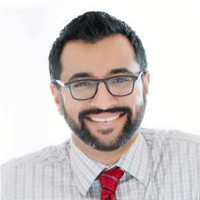Mechanisms of Trial-by-Trial Error Correction During Goal-Directed Arm Movements
Related Experiments | Key Publications | Collaborators | Future Investigations | Funding
The world in which we live is unpredictable. How does the brain optimize actions to achieve goals in the presence of uncertainty? In this project, we investigate how the brain uses explicit and implicit sensorimotor memories to shape future movements. We do so by asking people to perform goal-directed hand movements while a robotic device resists hand motion. By changing the robotic resistance between each reach attempt and by measuring the resulting performance, we can use time-series modeling techniques to reveal the extent to which sensorimotor memories from prior reaches influence subsequent attempts.
Related Experiments
- Behavioral and Neuroimaging Studies
- The Role of Implicit and Explicit Memories on Reach Adaptation
Sensorimotor adaptation is a form of motor learning whereby performance errors are compensated implicitly from one movement to the next. This project uses systems identification and time series analysis techniques to model trial-by-trial adaptive responses to mechanical perturbations during reaching. Our approach injects "information" into human learners by randomly changing perturbations opposing reaching movements to reveal how people use memories to predict and compensate for changing loads. We have developed a MR-safe robot and functional MRI analysis techniques to visualize neural mechanisms supporting error compensation during trial-to-trial adaptation, finding that multiple neural systems known to be involved in motor learning {basal ganglia, cerebellum, hippocampus} contribute to adapting sensorimotor control from one movement to the next.
Even in the simplest actions such as reaching, corrections for performance errors are comprised of separate components attributable to implicit sensorimotor adaptation and explicit strategic re-aiming. Both implicit and explicit mechanisms utilize memories of prior performance features to improve subsequent performance. This project introduces a new way to assess the contributions of explicit and implicit mechanisms to sensorimotor learning: Subjects grasp the handle of a planar robot while making rapid out-and-back reaches to a single visuospatial target. The robot opposes motion with spring-like loads that changed unpredictably from one reach to the next. Between movements, we sometimes require subjects to recall and report the hand's location at the moment of peak movement extent on the most recent trial; these self-assessments are used to provide visibility into explicit memory of kinematic performance (i.e. reach error). We use stepwise multilinear regression to fit models of sensorimotor adaptation to data from trial blocks performed with and without self-assessments to compare the contributions of implicit and explicit memories to the trial-by-trial compensation for variable environmental loads. We are testing the extent to which implicit and explicit memories both contribute meaningfully to the adaptation of kinematic performance during repeated practice of goal-directed reaching.
 Figure Caption: Our General Approach. A) Performance errors are induced by applying unpredictable perturbations during goal-directed reaching (black line). The brain uses sensorimotor memories or prior performance and perturbations to guide future movement, as quantified by our models (red line). B) A memory model describing the relative contributions of sensorimotor memories that guide the subsequent movement.
Figure Caption: Our General Approach. A) Performance errors are induced by applying unpredictable perturbations during goal-directed reaching (black line). The brain uses sensorimotor memories or prior performance and perturbations to guide future movement, as quantified by our models (red line). B) A memory model describing the relative contributions of sensorimotor memories that guide the subsequent movement.
Key Publications
Lantagne DD, Mrotek LA, Hoelzle, JB, Thomas DG, Scheidt RA (2023). Contribution of Implicit Memory to Adaptation of Movement Extent During Reaching Against Unpredictable Spring-Like Loads: Insensitivity to Intentional Suppression of Kinematic Performance. In Press: Experimental Brain Research.
Lantagne DD, Mrotek LA, Slick R, et al (2021). Contributions of implicit and explicit memories to sensorimotor adaptation of movement extent during goal-directed reaching. Exp Brain Res 239, 2445–2459 .
Lantagne D, Mrotek LA, Beardsley SA, Thomas DG, Leigh D, Ahamed SI, Scheidt RA (2019). The contribution of sensorimotor memories to implicit motor learning after concussion. Rocky Mount Bioeng Symp, Milwaukee, WI. Program Chairman's Award.
Judkins T, Scheidt RA (2014). Visuo-proprioceptive interactions during adaptation of the human reach. J Neurophysiol 111:868–887.
Scheidt RA, Zimbelman J, Salowitz N, Suminski A, Simo L, Houk J, Mosier KM (2012). Remembering forward: Neural correlates of memory and prediction in human motor adaptation. NeuroImage 59: 582–600.
Suminski A, Zimbelman J, Scheidt RA (2007). Design and validation of an MR-compatible pneumatic manipulandum. J. Neurosci Meth.163: 255–266 (2007).
Scheidt RA, Dingwell JB, Mussa-Ivaldi FA (2001). Learning to move amid uncertainty. J Neurophysiol 86:971–85.
Collaborators
Future Investigations
Future efforts will seek to translate this work into clinical applications, wherein the quantification of implicit memories may have diagnostic utility.
Funding
Experiments on this project are supported by Marquette University via Human Performance Research Center Pilot Grant and Strategic Innovation Fund Project (P5), as well as the National Science Foundation grant BES0238442 entitled, "CAREER: Adaptive control in biological and man-made systems."






